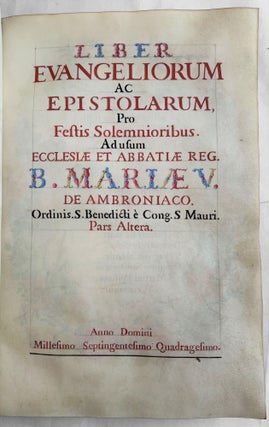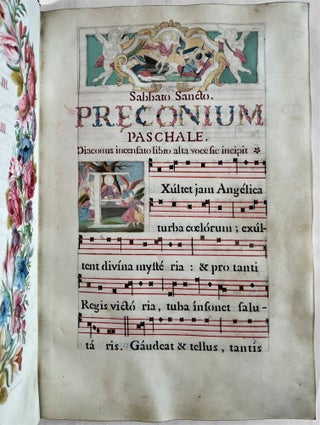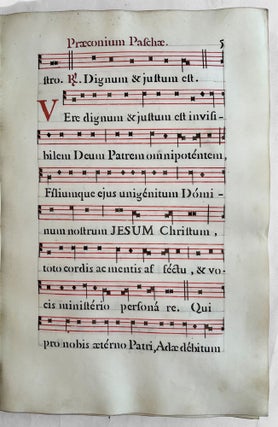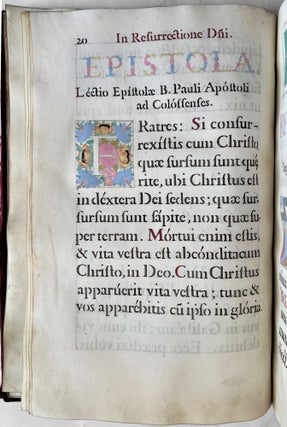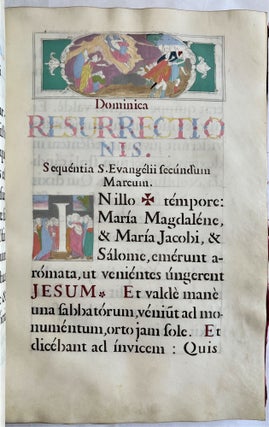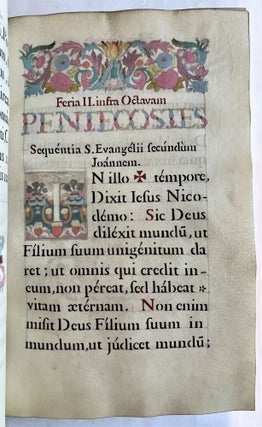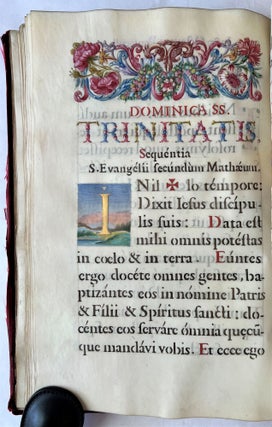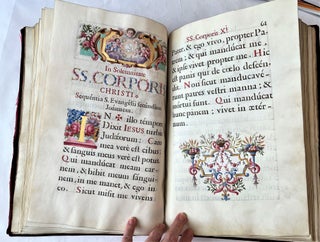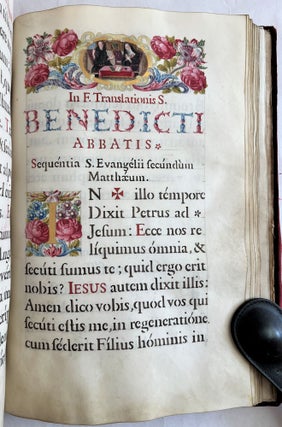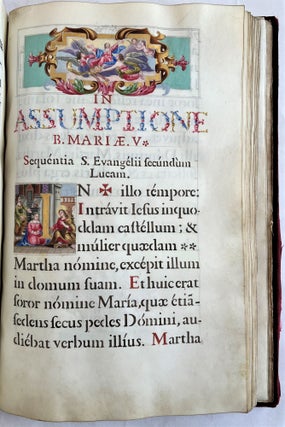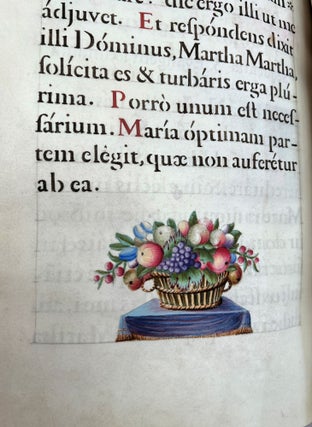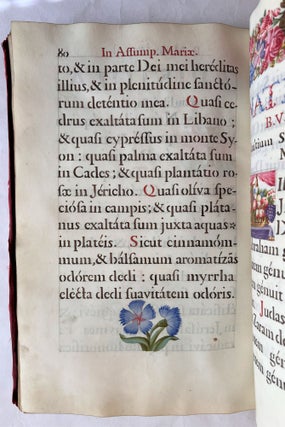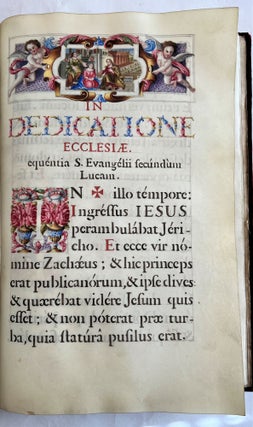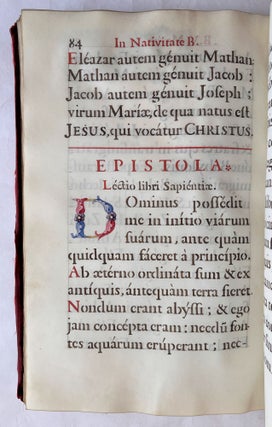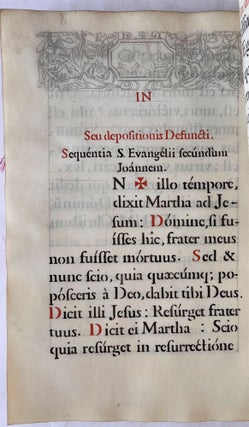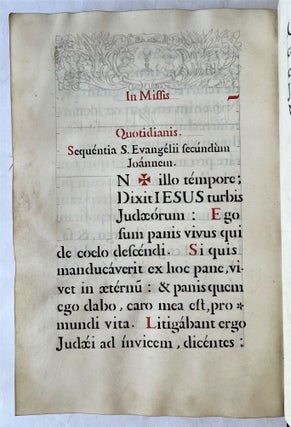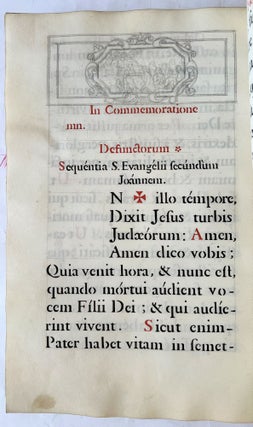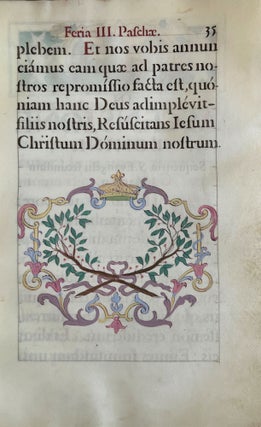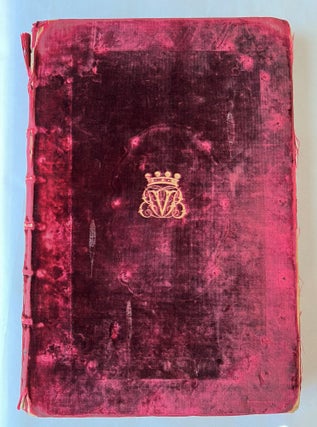Liber Evangeliorum ac Epistolarum, Pro Festis Solemnioribus. Ad usum Ecclesiae et Abbatiae Reg. B. Mariae V. de Ambroniaco. Ordinis S. Benedicti è Cong. S. Mauri. Pars Altera. Ambonay, France, 1740.
Illuminated and stencil-printed codex on vellum (335 x 227 mm). 64 leaves, paginated [2] 1-122, [1 blank page], 124-126. 3 vellum leaves and one paper flyleaf at front, and the same at back (recto of the first vellum leaf at back with border rule in pencil). Finis, p. 122; p. 124 with headline Appendix. Textually complete, but with the decoration unfinished. Pages 1-17 with music, square neumes on eight 4-line staves in red ink, the liturgical text beneath each line; stenciled text in three sizes (details below), the text and music carefully stenciled in brown and red inks. Lightly ruled in lead throughout with single bounding lines. Multi-colored decorative capitals (hand-drawn) used for two lines of title and portions of major section titles, running heads and minor section titles in red. Finely illuminated, the illumination in various stages of completion: title verso with full-page table of contents within illuminated floral wreath; 18 historiated or ornamental head-pieces preceding each feast, plus 3 sketched in pencil; 13 tail-piece vignettes and cartouches; 30 four-line historiated initials, and 13 simpler three-line decorative initials. Blank space in lower half of title-page, for a projected vignette, possibly a coat of arms. List of contents on title verso within large floral border and head-pieces and initials on pages 58-81 almost fully illuminated, including with liquid gold; in other sections the ornaments are illuminated but with the initials or other areas intended to be painted in gold still in reserve (unpainted); other sections are blocked out in pale wash colors only. Pages 110 to the end unilluminated, with pencil sketches of 3 head-piece ornaments and 3 initial “I”s, and blank spaces for the remaining decoration. Condition: small flaw with evidence of an old repair in blank margin of pp. 53-54, light staining in blank margins of p. 45 and 54, occasional marginal finger- or dust-soiling, otherwise in fine, fresh condition. Binding: contemporary red velvet over pasteboards, evidence of metal furniture since removed (an outer border and central oval cartouches), later gold-stamped monogram on upper cover, gilt edges, marbled endpapers (the velvet frayed at edges and head and tail of spine joints); housed in a modern suede-lined goatskin folding case. Provenance: Ambronay, Benedictines, Congregation of St-Maur; 19th-century gold-stamped cipher on binding with monogram BVE surmounted by a coronet, matching bookplate; with Maggs Bros Ltd., pencil inscription in gutter of blank vellum leaf at front; modern notes in pencil on verso of front free endleaf. ***
A lavishly produced stencil-printed evangeliary on vellum, illuminated by hand. Printed and painted on high-quality vellum, the stenciled letters of the text were applied with great exactitude, evenly spaced and aligned, with no blotting, errors or corrections. Intended as a luxurious ceremonial lectionary, its decoration was, however, never completed. Compounding its intrinsic interest as an unusually splendid example of a stencil-printed book, the various stages of illumination of this evangeliary provide a remarkable glimpse into the production methods of illuminated manuscripts and books of all types. This unique stenciled hand-painted evangeliary amounts to a veritable “open book” into the practices and methods of illuminators in this late period.
This copy is the second part of a liturgical guide to the gospel texts for the most important feast days. It was produced in the Benedictine monastery of Ambronay, northeast of Lyon. It combines moveable feasts from the Proper of the Times with a selection of fixed feasts from the Proper of the Saints. These are presented in a single quasi-chronological sequence beginning with the Easter Vigil and ending with All Saints. Several important Benedictine saints or feasts are included: the translation of St. Benedict (from Monte Cassino in Italy to Fleury in France); Saints Placidus and Maurus (the first disciples of St. Benedict, who share a feast day); St. Hugo, Abbot of Cluny (the most important Benedictine monastery in France); and a feast dedicated to the saints of the Benedictine order. A short addendum at the end of the main text contains commemorations of the dead.
The Maurist congregation had been founded in 1618, by letters patent of King Louis XIII, in order to reform the disorganized and “lax” Benedictine monasteries in France. Most of the Benedictine houses gradually joined the new congregation, which eventually embraced nearly two hundred houses. Promoting a return to a strict monastic regime, the Maurist order came to be identified as a fount of the most rigorous ecclesiastical and historical scholarship; its monks produced over 700 works, many of which remain definitive.
Stenciled liturgical books were produced in European monastic institutions from the late 17th through the 19th century. Produced using small tin sheets with cut-out letterforms and ornamental forms, stenciling provided a short cut to manufacturing “manuscripts.” Stenciling for liturgical books may have originated in the mid-17th century (at least that was the theory of Giles Fitteau des Billettes, who wrote the “pochoir” article on the process in the Description des Arts et Métiers, ca. 1700). Des Billettes noted that stencil-printing was used to produce the books needed for individual churches and convents, as opposed to religious books of more general application. The regular use of stenciling in monastic settings appears to have originated in France, before spreading throughout Catholic Europe. Stenciled books, which were produced in monastic scriptoria or ateliers, were often kept not in the monasteries’ libraries, but instead were housed with the cantor (Schrott, p. 1). This meant that most did not enter the book trade during the secularizations of the late 18th century. Many were discarded, and those that did survive were often poorly catalogued, being usually incorrectly identified as manuscripts. While many or most stenciled liturgical books included simple stenciled decoration, more splendid examples were hand-illuminated, as here (Constantinou illustrates examples of each, see pp. 182 and 183).
As stated above, the stenciling of this evangeliary was immaculately executed, evidently by an artisan-monk experienced in the technique. Three stencil series appear to have been used, with differently sized text bodies: in the largest, used for pages 18-122 (17 lines plus headline), the height of the lower-case l and q measure 9 mm.; in the next size, used for the chant and for the addendum, pages 124-126, lower-case l and q measure 7 mm.; the smallest text, in which lower-case l measures 6 mm., is used for the table of contents on the title verso and a few sub-headings.
Interestingly, the title appears at first glance to have been lettered by hand, but in fact only the two lines in decorative foliate capitals were produced in manuscript. A close look shows that the other lines, including those in red capitals, were stencil-printed, and the small gaps of the stencils were carefully filled in by hand. The same appears to be true of the table of contents, which includes, at the foot, a small stenciled ornament.
The fine decoration of this evangeliary is dominated by lavish floral arrangements, with birds, angels and geometrical cartouches containing biblical scenes, religious emblems, and portraits of saints or clerics (that on p. 72 shows a monk and a nun). The working method of the clearly skilled illuminator(s) who decorated this book can be easily traced in its pages. It varied little from earlier illumination practice. Starting with lead sketches (see pp. 110, 114, and 120), he blocked out the colors in wash (see pp. 18-55, 98). He then added the details in deeper colors, in watercolor and gouache, supplying faces, modeling, background patterns, etc., but leaving blank the initials and other elements which were to be illuminated in gold leaf (as in the initial and head-piece on p. 91). Finally, he added the gold leaf: only the central pages of the book, from pages 58 to 81, include gold, but even these seem to lack borders or final background touches, as some pencil borders are still visible.
The soft pastel colors of the unfinished paintings themselves are highly appealing; and the juxtaposition of full color illumination and soft wash coloring is especially striking, as in the first page opening, where the richer colors of the floral wreath border contrasts with the gentle pinks and greens of the head-piece and initial on the first text page.
Literature: on stenciling, see Eric Kindel, Stencil: a descriptive bibliography, Reading: Éditions à jour, 2019; Meghan Constantinou, “A Secular Stenciled Book: the Library Catalogue of Charles-Antoine de Billy, 1742–ca 1760,” Journal of the Printing Historical Society, third series 2 (2021), pp. 170-201; G. Schrott, “Schablonierte Choralbücher. Buchgeschichtliche Entdeckungen auf den zweiten Blick,” in Ordensgeschichte. Ein interdisziplinäres Gemeinschaftsblog zur Geschichte von Klöstern und Orden, 2019. On earlier illumination practice, see J. Alexander, Medieval Illuminators and their Methods of Work (New Haven, 1992). Item #4227
No longer available


